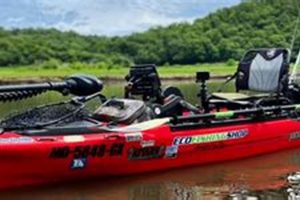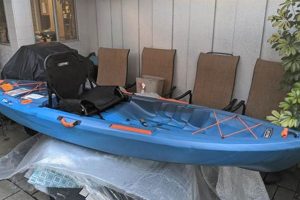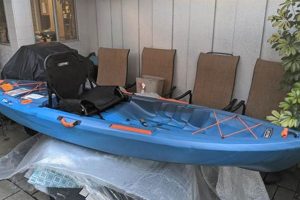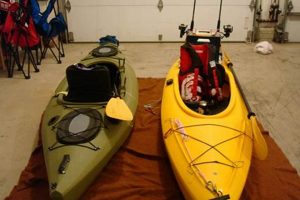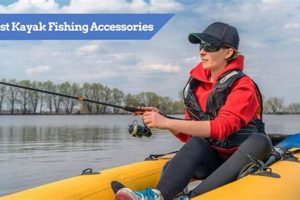Optimizing a fishing kayak with appropriate equipment enhances angler safety, comfort, and efficiency. Examples include rod holders, fish finders, and dry storage compartments, each tailored to specific needs and fishing styles. Choosing suitable gear can transform a standard kayak into a personalized fishing platform.
Efficient angling requires more than just a kayak and a rod. Specialized equipment improves organization, allowing anglers to focus on fishing rather than managing gear. Comfort features, like adjustable seating and storage solutions, extend fishing trips by reducing fatigue. Safety enhancements, such as lighting and personal flotation devices specifically designed for kayak fishing, are paramount. Over time, advancements in materials and design have led to lighter, more durable, and more specialized equipment, significantly improving the kayak fishing experience.
This article will explore various essential equipment categories for kayak fishing, considering factors like fishing style, budget, and personal preferences. Topics covered will include navigation and safety equipment, storage solutions, fishing-specific accessories, and comfort enhancements, providing a comprehensive guide to outfitting a fishing kayak.
Essential Equipment Tips for Kayak Fishing
Careful selection of kayak fishing accessories significantly impacts angling success and safety. The following tips offer guidance for optimizing equipment choices.
Tip 1: Prioritize Safety. A personal flotation device (PFD) designed specifically for kayak fishing is paramount. Consider a brightly colored PFD with pockets for essential tools. A whistle, signaling mirror, and waterproof flashlight enhance visibility and safety in emergencies.
Tip 2: Choose Appropriate Rod Holders. Rod holders free hands for paddling and other tasks. Flush-mount rod holders offer a streamlined profile, while adjustable rod holders provide versatility for different fishing techniques. Consider the number of rods typically used when selecting the quantity of holders.
Tip 3: Invest in a Fish Finder. A fish finder provides crucial underwater insights, revealing depth, structure, and fish locations. Choose a model with GPS capabilities for marking productive spots and navigating unfamiliar waters. Transducer mounting options vary depending on kayak design.
Tip 4: Optimize Storage Solutions. Dry bags and waterproof containers protect valuable electronics and personal items from water damage. Crates and tackle boxes offer organized storage for fishing gear. Consider weight distribution and accessibility when organizing storage.
Tip 5: Enhance Comfort. Adjustable seating with lumbar support reduces fatigue during long fishing trips. Footrests provide stability and leverage for paddling. Consider a kayak with adjustable features to accommodate individual body types.
Tip 6: Consider an Anchor Trolley System. An anchor trolley system allows for controlled positioning in various water conditions and fishing scenarios. This is especially beneficial in windy conditions or when fishing current breaks.
Tip 7: Select a Suitable Paddle. Choose a lightweight, durable paddle appropriate for the kayak’s width and the angler’s height. A paddle leash prevents loss in the event of a capsize.
Strategic equipment choices enhance safety, comfort, and fishing success. Investing in quality gear contributes to a more enjoyable and productive experience on the water.
By understanding the various options and considering individual needs, anglers can effectively equip their kayaks for optimal performance.
1. Safety Equipment
Safety equipment constitutes a critical subset of essential accessories for fishing kayaks. The inherent risks of on-water activities necessitate prioritizing safety gear. A failure to equip a fishing kayak with appropriate safety devices can lead to severe consequences, ranging from minor injuries to life-threatening situations. For instance, a sudden capsize without a personal flotation device (PFD) could prove fatal, especially in cold water or strong currents. Similarly, a signaling device, such as a whistle or mirror, can be crucial for attracting attention in an emergency, particularly in areas with limited visibility or cell phone reception.
Several factors influence the specific safety equipment choices for a fishing kayak. Fishing location, weather conditions, and personal experience level should inform these decisions. Coastal saltwater fishing presents different challenges compared to calm inland lakes, demanding potentially more robust safety measures. Cold weather environments require additional precautions against hypothermia, such as specialized PFDs or immersion suits. Experienced anglers might choose additional safety accessories based on specific past experiences or anticipated challenges. Practical application involves not just possessing safety equipment, but also ensuring its proper functionality and accessibility. Regularly inspecting PFDs for wear and tear and practicing using signaling devices ensures preparedness in critical situations.
Integrating safety equipment into the “best accessories” framework acknowledges the fundamental importance of mitigating risk in kayak fishing. While enhancing fishing performance through specialized gear is valuable, prioritizing safety ensures the angler’s well-being. Understanding the potential hazards and equipping the kayak accordingly transforms a recreational activity into a responsible and safe pursuit. This proactive approach safeguards against unforeseen circumstances and allows for a more confident and enjoyable fishing experience.
2. Rod Holders
Rod holders represent a crucial component within the “best accessories for fishing kayak” framework. Their primary function, securing fishing rods, directly impacts angling efficiency and safety. Without dedicated rod holders, anglers face the cumbersome task of constantly managing rods while paddling, maneuvering, and landing fish. This not only reduces fishing time but also increases the risk of losing rods overboard or entanglement. Dedicated rod holders free hands for essential tasks, contributing significantly to a more organized and productive fishing experience. For example, trolling multiple lines becomes significantly more manageable with appropriate rod holders, allowing anglers to cover more water and increase their chances of success. Similarly, fighting a strong fish becomes safer and more controlled when the rod is securely positioned in a holder, preventing loss of balance or leverage. Practical applications extend beyond simply holding rods; adjustable rod holders allow anglers to customize angles for specific fishing techniques, optimizing lure presentation and hook sets.
The choice of rod holders depends on factors like fishing style and kayak type. Flush-mount rod holders offer a streamlined profile for minimal interference while paddling, ideal for kayaks navigating tight spaces. Adjustable rod holders provide versatility for various fishing techniques, allowing anglers to change rod angles based on the target species and fishing conditions. Track-mounted systems offer flexible placement options, adapting to individual preferences and fishing styles. Considering these factors ensures rod holders complement the overall kayak setup, maximizing functionality and efficiency. For instance, a kayak angler targeting large pelagic fish might prioritize heavy-duty rod holders with gimbal mounts for added stability and strength, while a bass angler might prefer adjustable rod holders for precise lure presentation in shallow water.
Effective rod holder selection contributes significantly to a positive kayak fishing experience. Beyond the obvious benefits of securing rods and freeing hands, appropriate rod holders minimize equipment damage, reduce angler fatigue, and ultimately contribute to greater fishing success. Integrating rod holders into the broader “best accessories” framework acknowledges their integral role in optimizing kayak fishing efficiency and safety. Careful consideration of individual fishing needs and kayak configuration ensures rod holders contribute effectively to a well-equipped and productive fishing platform.
3. Fish Finders
Fish finders represent a pivotal technological advancement within the “best accessories for fishing kayak” landscape. Their capacity to provide real-time underwater insights significantly enhances angling effectiveness. Prior to widespread fish finder adoption, kayak anglers relied heavily on experience, intuition, and visible surface features to locate fish. Fish finders transform this process by offering a detailed view of underwater topography, water temperature, and fish presence. This information empowers anglers to make informed decisions regarding location selection, lure choice, and fishing depth, significantly increasing the likelihood of success. For instance, identifying a thermocline or a submerged structure, both easily discernible on a fish finder, allows anglers to target specific areas where fish are likely to congregate. Similarly, observing baitfish activity on the fish finder screen provides valuable clues about predator locations. This data-driven approach contrasts sharply with traditional methods and allows for more strategic and efficient fishing.
Practical applications of fish finders in kayak fishing are numerous. Mapping underwater structures, such as drop-offs, reefs, and submerged vegetation, allows anglers to create detailed fishing maps over time. Tracking fish movements and understanding their behavior in relation to environmental factors, like water temperature and current, further refines fishing strategies. GPS integration in many modern fish finders adds another layer of utility, enabling precise navigation, waypoint marking, and tracking of drift patterns. This integrated approach combines fish finding technology with navigational tools, creating a powerful platform for optimizing fishing locations and strategies. Consider a scenario where an angler locates a productive underwater structure using a fish finder. The GPS functionality allows them to mark this location and return to it precisely on future fishing trips, ensuring consistent access to promising fishing grounds. This combination of technology and strategy significantly elevates fishing success rates.
Integrating fish finders into the “best accessories” framework acknowledges their transformative impact on kayak fishing. While traditional methods still hold value, fish finders provide a significant advantage in terms of efficiency and strategic decision-making. Challenges associated with fish finder implementation, such as choosing the right transducer and mounting it effectively on a kayak, are easily overcome with readily available resources and information. The benefits of utilizing fish finder technology far outweigh these minor challenges, solidifying its place as a crucial element in optimizing kayak fishing success. The ability to understand the underwater environment with greater precision transforms kayak fishing from a largely experience-based pursuit to a data-driven activity, ultimately leading to more consistent and productive results.
4. Storage Solutions
Effective storage solutions are integral to the “best accessories for fishing kayak” concept. Limited space on a kayak necessitates efficient organization and readily accessible gear. Well-designed storage directly impacts fishing success by streamlining tackle management and preserving essential equipment. A disorganized kayak impedes efficient lure changes, hinders access to critical tools, and potentially compromises safety.
- Tackle Organization
Efficient tackle organization maximizes fishing time and minimizes frustration. Dedicated tackle boxes, trays, and bags designed for kayak fishing keep lures, hooks, weights, and other small items readily accessible. Modular systems allow for customization based on fishing style and target species. For example, a bass angler might organize their tackle by lure type (crankbaits, jigs, soft plastics), while a saltwater angler might prioritize different leader materials and hook sizes. This systematic approach streamlines lure changes, reduces wasted time searching for specific items, and contributes to a more focused and productive fishing experience.
- Dry Storage
Protecting essential items from water damage is paramount in kayak fishing. Dry bags, waterproof cases, and sealed compartments safeguard electronics, phones, wallets, and other valuables. Choosing appropriate dry storage considers the size and type of items needing protection. For instance, a larger dry bag might store extra clothing and a first-aid kit, while smaller waterproof cases protect phones and cameras. Investing in reliable dry storage prevents costly replacements due to water damage and ensures essential gear remains functional throughout the fishing trip. This proactive approach safeguards against unexpected splashes, submersions, or capsizes, preserving essential equipment and enhancing overall safety.
- Space Management
Efficient space management optimizes limited kayak real estate. Utilizing available storage compartments effectively, incorporating under-seat storage, and strategically positioning gear within easy reach contributes to a balanced and organized kayak. Weight distribution considerations influence stability and paddling efficiency. For example, distributing heavier items lower and towards the center of the kayak enhances stability, while keeping frequently used items within arm’s reach minimizes disruptive movements. Thoughtful space management transforms a potentially cramped kayak into a well-organized and efficient fishing platform.
- Rod and Paddle Storage
Secure rod and paddle storage enhances safety and prevents equipment loss. Rod holders keep rods organized and readily accessible while paddling or fighting fish. Paddle leashes and clips secure paddles and prevent them from drifting away in the event of a capsize. This is particularly important in moving water or windy conditions. Integrating rod and paddle storage into the overall storage strategy minimizes clutter, streamlines transitions between paddling and fishing, and safeguards valuable equipment. This organized approach reduces the risk of entanglement, improves safety, and contributes to a more efficient and enjoyable fishing experience.
Effective storage solutions are indispensable for optimizing kayak fishing. By strategically organizing tackle, protecting valuables from water damage, managing space efficiently, and securing rods and paddles, anglers transform their kayaks into well-equipped and efficient fishing platforms. Prioritizing storage within the “best accessories” framework contributes significantly to enhanced safety, increased fishing time, and ultimately, a more successful and enjoyable experience on the water.
5. Comfort Enhancements
Comfort enhancements represent a crucial aspect of the “best accessories for fishing kayak” equation. Extended periods on the water, inherent in kayak fishing, necessitate prioritizing ergonomic design and individualized comfort adjustments. Discomfort detracts from focus, reduces fishing time, and can lead to premature fatigue. Optimized comfort, conversely, allows anglers to remain on the water longer, focus on fishing, and fully enjoy the experience. A well-chosen seat, for example, significantly impacts comfort. Standard kayak seats often lack adequate back support, leading to discomfort and fatigue, particularly during long fishing trips. Upgrading to an adjustable seat with lumbar support and breathable fabric enhances comfort and promotes better posture, enabling anglers to fish comfortably for extended periods.
Practical applications of comfort enhancements extend beyond seating. Footrests or adjustable foot braces provide essential leverage for paddling and stability while fishing. Proper foot placement contributes to efficient paddling, reducing fatigue and strain on leg muscles. Similarly, a well-designed backrest promotes proper posture and reduces back pain, especially during long hours on the water. These seemingly minor adjustments can significantly improve overall comfort and endurance, enabling anglers to fish longer and more effectively. Consider an angler targeting offshore species; a comfortable and stable seating position allows them to focus on battling strong fish without being hindered by discomfort or instability. This practical application underscores the direct link between comfort enhancements and fishing success.
Integrating comfort enhancements into the “best accessories” framework acknowledges their essential contribution to a positive kayak fishing experience. While specialized fishing gear enhances angling effectiveness, prioritizing comfort ensures anglers can utilize that gear optimally. Addressing potential discomfort proactively through appropriate accessories transforms a potentially tiring outing into a more enjoyable and productive experience. Challenges associated with integrating comfort enhancements, such as finding accessories compatible with specific kayak models, are easily overcome with readily available information and resources. The resulting benefits, in terms of enhanced endurance, improved focus, and increased overall enjoyment, solidify comfort enhancements as a vital component within the “best accessories for fishing kayak” concept.
Navigation aids constitute a critical component within the “best accessories for fishing kayak” framework. Safe and efficient navigation underpins successful kayak fishing, impacting both angler safety and the ability to locate productive fishing grounds. Without reliable navigational tools, anglers risk disorientation, particularly in unfamiliar waters, challenging weather conditions, or during extended trips. Effective navigation aids empower anglers to explore confidently, maximize fishing time, and ensure safe return.
- GPS Units and Chartplotters
GPS units and chartplotters provide precise location information, enabling navigation to specific coordinates, marking waypoints (like productive fishing spots or navigation hazards), and tracking routes. Integrated with electronic charts, these devices offer a comprehensive view of waterways, including depth contours, navigational markers, and potential hazards. In practical application, a kayak angler might use a GPS/chartplotter combination to navigate to a known reef, mark a newly discovered drop-off, or track their drift pattern while fishing a specific current line. This precise navigational capability enhances efficiency and safety, allowing anglers to focus on fishing rather than constantly orienting themselves.
- Compasses
Compasses provide a reliable directional reference, independent of electronic systems. While GPS technology offers precise location data, compasses remain valuable as a backup navigation tool, particularly in situations where electronic devices malfunction or experience battery failure. A compass allows anglers to maintain a general bearing, especially useful in conditions of limited visibility or when navigating unfamiliar shorelines. Practical application involves using a compass in conjunction with a map to maintain course, navigate around obstacles, or return to a launch point in the absence of electronic navigation. This redundancy enhances safety and provides a critical backup navigation solution.
- VHF Radios
VHF radios facilitate communication with other boaters, marinas, and emergency services. Broadcasting distress calls, receiving weather updates, and coordinating with fishing partners enhances safety and situational awareness. In practical application, a VHF radio enables an angler to call for assistance in case of an emergency, receive real-time weather alerts, or communicate with other anglers in their group. This communication capability significantly enhances safety and provides a critical link to external resources in case of unforeseen circumstances. Furthermore, knowledge of proper VHF radio protocols and procedures ensures effective communication in critical situations.
- Navigation Lights
Navigation lights enhance visibility in low-light conditions, ensuring kayaks remain visible to other vessels. Required by law for nighttime operation, navigation lights significantly reduce the risk of collisions, especially in areas with heavy boat traffic. Practical application involves using appropriate navigation lights a white light visible from all directions and a red and green sidelight during periods of reduced visibility, including nighttime, fog, or heavy rain. This proactive approach enhances safety and ensures compliance with navigational regulations, contributing to a safer boating environment for all.
Effective navigation represents a fundamental aspect of safe and successful kayak fishing. Integrating appropriate navigation aids into the “best accessories for fishing kayak” framework acknowledges the critical role these tools play in enhancing both efficiency and safety on the water. By utilizing GPS technology, maintaining a compass as a backup, ensuring communication capabilities through VHF radio, and enhancing visibility with navigation lights, anglers equip themselves for confident exploration and safe return, ultimately maximizing the enjoyment and productivity of their kayak fishing experience.
Frequently Asked Questions
This section addresses common inquiries regarding essential accessories for fishing kayaks.
Question 1: What is the most crucial safety accessory for kayak fishing?
A properly fitted personal flotation device (PFD) designed specifically for kayak fishing is paramount. It provides essential buoyancy in the event of a capsize and should be worn at all times while on the water.
Question 2: How many rod holders are recommended for a fishing kayak?
The optimal number of rod holders depends on individual fishing style and target species. Two to four rod holders generally suffice for most kayak anglers. Multiple holders allow for diverse fishing techniques and accommodate different rod types.
Question 3: Are fish finders necessary for successful kayak fishing?
While not strictly necessary, fish finders significantly enhance angling efficiency by providing real-time underwater insights. They assist in locating fish, identifying underwater structures, and understanding water conditions, leading to more informed fishing decisions.
Question 4: What type of storage solutions are best suited for kayaks?
Waterproof storage solutions are essential for protecting valuables from water damage. Dry bags, waterproof cases, and sealed compartments safeguard electronics, personal items, and essential gear from splashes and submersion. Tackle boxes designed for kayak fishing facilitate organized tackle management.
Question 5: How can kayak fishing comfort be improved?
Upgrading to an adjustable kayak seat with lumbar support significantly enhances comfort during long fishing trips. Footrests or adjustable foot braces provide essential leverage for paddling and stability. These comfort enhancements reduce fatigue and allow for longer, more enjoyable fishing sessions.
Question 6: What navigation aids are recommended for kayak fishing?
A GPS unit or chartplotter facilitates navigation to specific locations and marking productive fishing spots. A compass serves as a reliable backup navigation tool. VHF radios enhance safety by enabling communication in emergencies and providing access to weather updates. Navigation lights are essential for visibility in low-light conditions.
Careful consideration of these frequently asked questions assists in selecting the most appropriate accessories for optimizing kayak fishing safety, efficiency, and overall enjoyment.
This information provides a solid foundation for making informed decisions regarding essential kayak fishing accessories.
Optimizing Kayak Fishing through Strategic Accessory Selection
Careful selection of accessories significantly impacts kayak fishing success. Prioritizing safety with PFDs and signaling devices, enhancing fishing efficiency with rod holders and fish finders, maximizing organization through appropriate storage solutions, and ensuring comfort with adjustable seating and footrests collectively contribute to a more productive and enjoyable experience. Navigation aids, including GPS units, compasses, and VHF radios, further enhance safety and allow for exploration of new fishing grounds. Understanding the function and application of these key accessory categories empowers anglers to equip their kayaks strategically.
Strategic accessory choices transform a standard kayak into a personalized fishing platform optimized for individual needs and fishing styles. Investing in appropriate gear enhances not only fishing success but also overall safety and comfort on the water. The evolution of kayak fishing accessories continues to drive innovation, offering anglers increasingly sophisticated tools to enhance their experience. Continued exploration of available options and careful consideration of individual needs and fishing styles remain essential for maximizing performance and enjoyment on the water.


